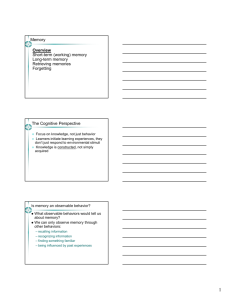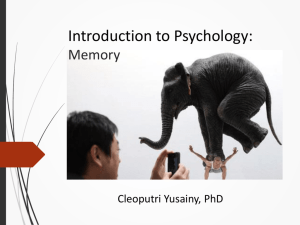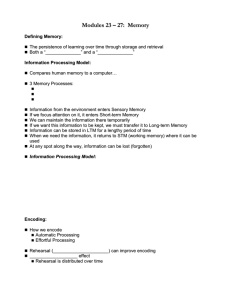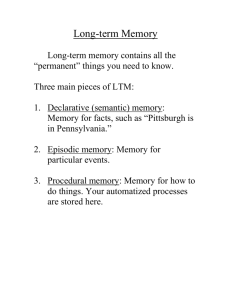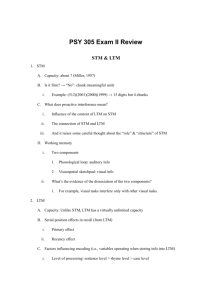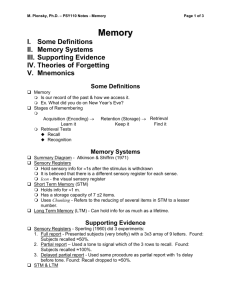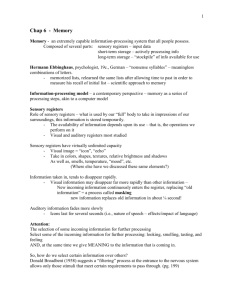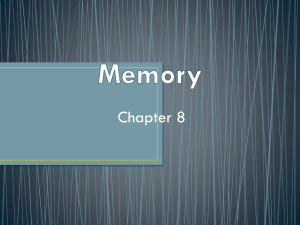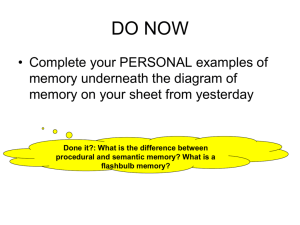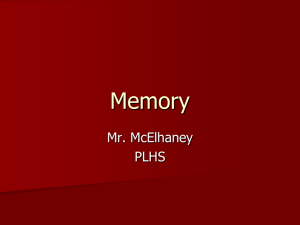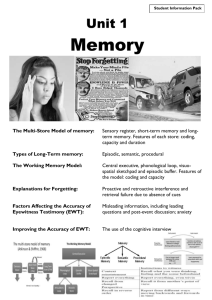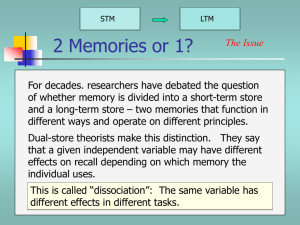Psychology Unit 3 Outcome 2
advertisement
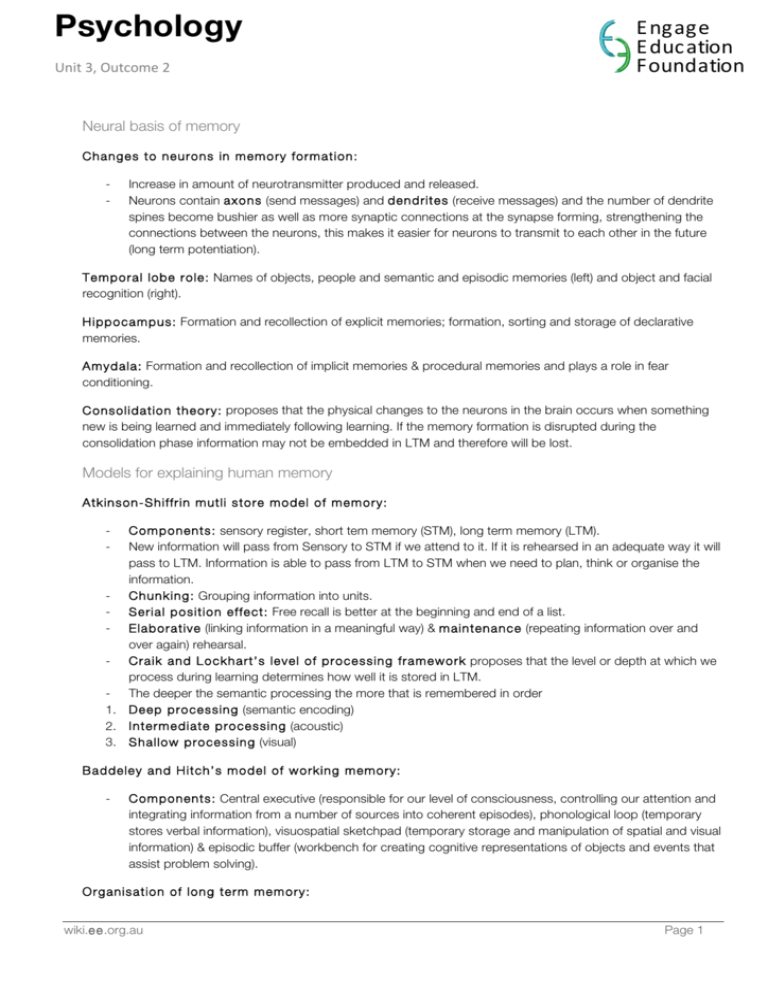
Psychology Unit 3, Outcome 2 E ngage E ducation Foundation Neural basis of memory Changes to neurons in memory formation: - Increase in amount of neurotransmitter produced and released. Neurons contain axons (send messages) and dendrites (receive messages) and the number of dendrite spines become bushier as well as more synaptic connections at the synapse forming, strengthening the connections between the neurons, this makes it easier for neurons to transmit to each other in the future (long term potentiation). Temporal lobe role: Names of objects, people and semantic and episodic memories (left) and object and facial recognition (right). Hippocampus: Formation and recollection of explicit memories; formation, sorting and storage of declarative memories. Amydala: Formation and recollection of implicit memories & procedural memories and plays a role in fear conditioning. Consolidation theory: proposes that the physical changes to the neurons in the brain occurs when something new is being learned and immediately following learning. If the memory formation is disrupted during the consolidation phase information may not be embedded in LTM and therefore will be lost. Models for explaining human memory Atkinson-Shiffrin mutli store model of memory: - Components: sensory register, short tem memory (STM), long term memory (LTM). New information will pass from Sensory to STM if we attend to it. If it is rehearsed in an adequate way it will pass to LTM. Information is able to pass from LTM to STM when we need to plan, think or organise the information. - Chunking: Grouping information into units. - Serial position effect: Free recall is better at the beginning and end of a list. - Elaborative (linking information in a meaningful way) & maintenance (repeating information over and over again) rehearsal. - Craik and Lockhart’s level of processing framework proposes that the level or depth at which we process during learning determines how well it is stored in LTM. - The deeper the semantic processing the more that is remembered in order 1. Deep processing (semantic encoding) 2. Intermediate processing (acoustic) 3. Shallow processing (visual) Baddeley and Hitch’s model of working memory: - Components: Central executive (responsible for our level of consciousness, controlling our attention and integrating information from a number of sources into coherent episodes), phonological loop (temporary stores verbal information), visuospatial sketchpad (temporary storage and manipulation of spatial and visual information) & episodic buffer (workbench for creating cognitive representations of objects and events that assist problem solving). Organisation of long term memory: wiki.ee.org.au Page 1 - Procedural memory: Memory of actions ands skills needed to carry out a procedure. Declarative memory: Memory of specific facts or events that can be brought into consciousness awareness. Episodic memory: Declarative memory of specific events or personal experiences. Semantic memory: Declarative memory of information about the world. Semantic network theory: Information in LTM is organised systematically in the form of overlapping networks of concepts that are interconnected and interrelated by meaningful links. Memory decline over a lifespan: • There is sometimes a natural decline of memory in older people. Recall declines with age. Aging causes a slowing of the CNS leading to slow processing of information in STM. It appears that episodic memories decline more than procedural memories. The speed & fluency of retrieval of information from LTM slows • Neurogenerative diseases: progressive decline in the structure and function of brain tissue. Such diseases include Dementia and Alzheimer’s disease. Anterograde: Cannot form new memories. Retrograde: Cannot remember past. • • Theories of forgetting • Forgetting curve: shows the rate & amount of forgetting that occurs over time. The greatest rate of forgetting occurs immediately after learning with the most rapid decline 20 minutes after learning. Moderate decline after 1 hour and after 8 hours the memory loss slows to a minor rate of decline. • Retrieval failure: the inability to retrieve information because of the absence of the right cues. The tip of the tongue phenomenon occurs when someone knows that something is contained in their LTM but it cannot be retrieved due to the absence of the right cures. • Interference failure: information is lost or cannot be retrieved because of the competition from other material. Proactive interference (interference of old memories with the learning of new information) and retroactive interference (the learning of new information affects the recall of old memories) Motivated forgetting: The blocking of a painful memory of an experience from consciousness awareness due to a strong desire to prevent the recall of a traumatic event. It can be done unconsciously (repression) or consciously (suppression). • • Decay theory: Memory fades over time. When information is not revised it is forgotten due to the gradual loss of the physical/chemical trace of the memory that was created when the memory was formed. It is believed that a gradual loss of neural pathways in the hippocampus is responsible. Retrieval cues fail to trigger the memory if the memory is lost. Manipulation and improvement of memory In increasing sensitivity (the ability to asses the amount of information stored in memory): Recall <Recognition <Relearning Context dependent (environmental) and state dependent (internal physiological and/or psychological state) associated at the time the memory was formed that act as retrievals cues to help assess those memories. Mnemonics: acronyms (pronounceable words), acrostics (verbal associations with first letters) & narrative chaining (meaning sequence or story) used to manipulate the information to be remembered. Elizabeth Loftus: leading questions could be used to inaccurately reconstruct memory, demonstrating unreliability of LTM because we can incorporate new information each time a memory is recalled to the STM. wiki.ee.org.au Page 2


